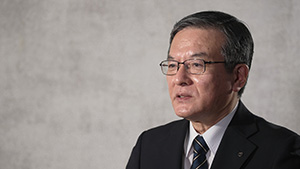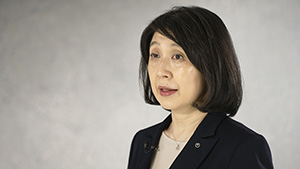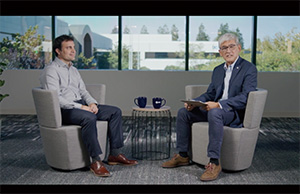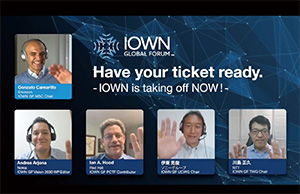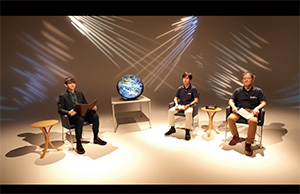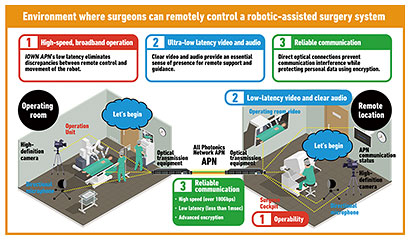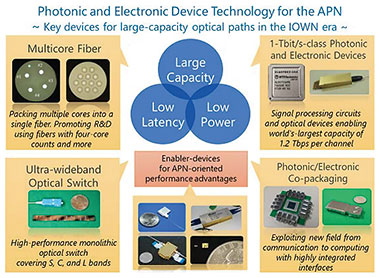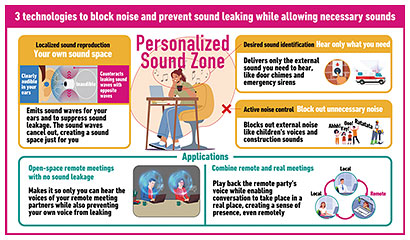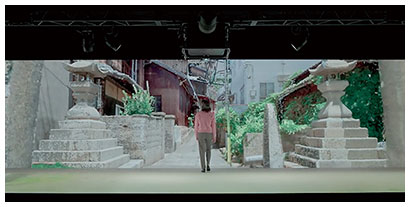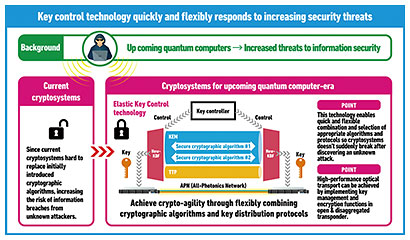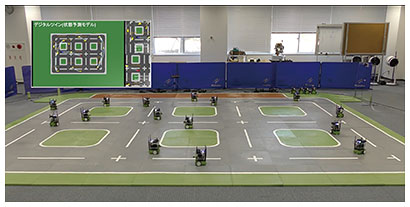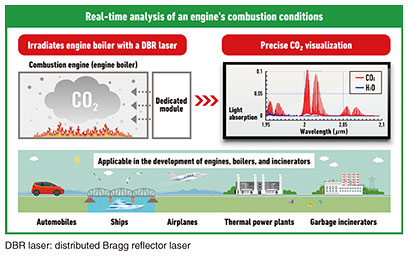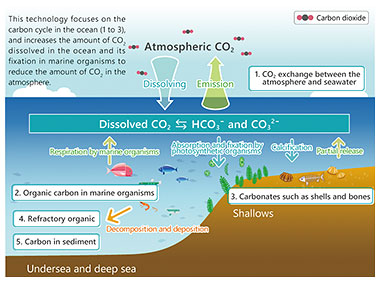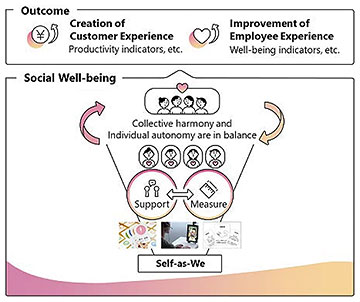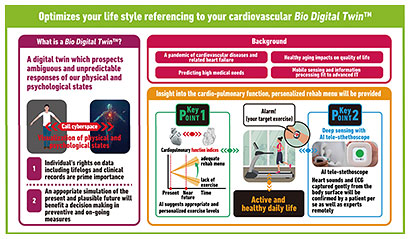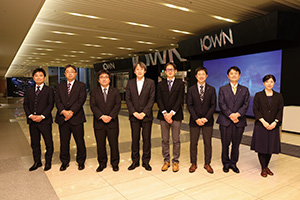 |
|
|
|
|
|
Information Vol. 21, No. 3, pp. 38–48, Mar. 2023. https://doi.org/10.53829/ntr202303in1 Report on NTT R&D Forum—Road to IOWN 2022AbstractNTT R&D Forum—Road to IOWN 2022 was held from November 16th to 18th, 2022. The following is an introductory overview of the Forum. Keywords: R&D Forum, IOWN, latest technology 1. Forum overviewWith the commercialization of Innovative Optical and Wireless Network (IOWN)1.0 services close at hand, NTT R&D Forum 2022 introduced the latest achievements of NTT research and development (R&D) toward the further evolution of large-capacity, low-latency, and low-power communication technologies. It featured keynote speeches by Akira Shimada, president and chief executive officer (CEO) of NTT Corporation, and Atsuko Oka, executive vice president, head of the Research and Development Planning Department of NTT Corporation, and three special sessions by members of the IOWN Global Forum as well as more than 90 research exhibits. The technology roadmap that has been under consideration is finally taking shape and the light of IOWN is about to shine. We report on this NTT R&D Forum successfully held online under the theme of “Road to IOWN 2022.” 2. Keynote speeches/special sessions2.1 Keynote Speech 1Under the theme of “IOWN1.0—Start of IOWN Service,” Akira Shimada, president and CEO of NTT Corporation, delivered a keynote speech centered on IOWN services scheduled for launch at the end of FY2022 (Photo 1).
President Shimada first touched upon key issues that arise in a “data-driven society” in which actions are taken on the basis of data generated by a wide variety of devices making up the Internet of Things (IoT). These include a significant increase in data capacity and power consumption as well as communication delays. He announced the commercialization of All-Photonics Network (APN) services by March 2023 as the first round of IOWN services (i.e., IOWN1.0) to address these issues. He then went on to describe how APN services could be applied to a variety of services such as remote medicine, smart factories, and e-sports among remote players by achieving communications that satisfy IOWN performance targets, i.e., a delay 1/200 the current level with no flicker. He also presented the possibility of treating multiple datacenters as a single datacenter by interconnecting them with high-capacity, low-latency circuits. Next, President Shimada talked about “photonics-electronics convergence devices” that merge optical and electronic circuits as key power-efficient devices that represent the most outstanding feature of IOWN. The plan is to apply these devices not only to networking but also to computing to achieve a drastic reduction in power consumption. He also announced a detailed plan for service development that, while applying and expanding these photonics-electronics convergence devices to APN services and servers, IOWN would increase communication capacity by 125 times in IOWN3.0 in 2029 and increase power efficiency by 100 times in IOWN4.0 and beyond as performance targets. Finally, President Shimada introduced the urban development of Urbannet Nagoya nexta Building as an example of Digital Twin Computing that represents diverse digital copies of real space in cyber space to conduct data analysis and simulations for predicting the future. He described how services for air conditioning control and reduction of food waste would be commercialized and implemented in FY2023 and how such a development would “contribute to people-friendly and earth-friendly urban development” while promoting service enhancement and expansion. With a view to Expo 2025 Osaka, Kansai, Japan, President Shimada also declared that NTT would be announcing pavilion exhibits and the commercialization of IOWN2.0 services. For details, please see the article titled “IOWN1.0—Start of IOWN Service” in this issue. 2.2 Keynote Speech 2Atsuko Oka, executive vice president, head of Research and Development Planning Department of NTT Corporation, also delivered a keynote speech under the theme of “Road to IOWN – Light Up –.” She described how the actual provision of IOWN services would begin at the end of FY2022 and that IOWN would finally shine its light on users (Photo 2).
Though currently at the conceptual level, IOWN is about to enter a practical phase, and with this in mind, Executive Vice President Oka announced a variety of research findings as the first round of research results of the IOWN initiative. In the first topic of her speech, “IOWN Datacenter × APN,” Executive Vice President Oka described the need for interconnecting NTT datacenters by the APN and accelerating service development in a large-scale and practical environment. To deal with the trend toward increasingly larger datacenters, she explained a plan to make operations more efficient through the APN while decentralizing datacenters. This approach has the potential of solving the problem of securing land and power. She also introduced two examples of APN-related achievements. One is the development of a digital coherent signal processing circuit that can achieve an optical-fiber transmission capacity of 1.2 Tbit/s per wavelength. The other is the creation of a 400-Gbit/s co-package prototype for transceivers. She revealed that these technologies should be commercialized in 2023 and that research would continue on basic technologies for supporting next-generation ultra-high-capacity communications. Executive Vice President Oka also pointed out that “the current environment that combines AI [artificial intelligence] and IoT has a network problem,” and that NTT would solve this problem by interconnecting datacenters by the APN to create a “true industrial infrastructure.” Given that “high transmission performance for conveying reality” is an intrinsic property of the APN, Executive Vice President Oka presented remote surgery as a use case of the APN that supports the transmission of visual, acoustic, verbal, and even tactile information essential to reproducing reality. Then, from among a variety of acoustic and voice technologies that NTT has long been researching, she announced the development of advanced acoustic technology for wirelessly controlling underwater drones. She also introduced the world’s first earphones and speakers using Personalized Sound Zone (PSZ) technology that generates only the sound that you want to hear and cancels out unwanted ambient noise. For details, please see the article titled “Road to IOWN – Light Up –” in this issue. 2.3 Special Session 1In Special Session 1, “Protocols for Post Quantum Cryptography,” Dr. Brent Waters, director of Cryptography & Information Security Laboratories (CIS Lab), NTT Research, Inc., spoke with Kazuhiro Gomi, president and CEO of NTT Research, about the current research in this field (Photo 3).
Dr. Waters began the discussion by talking about the problem of using quantum computing to break public-key encryption, one of the encryption systems now in use. Learning with error, which adds error during inner-product computation, is a lattice-based encryption scheme that can withstand even calculations by a quantum computer, and Dr. Waters explained that this function has various benefits apart from post-quantum cryptography. Next, in response to the question: “Can public-key encryption be protected against malicious acts?” Dr. Waters replied “Definitely yes!” In support of his answer, he touched upon a method that can avoid the risk of security breaches, citing fully homomorphic encryption technology proposed by Craig Gentry in 2009. This method “enables computations to be performed on received data despite knowing nothing about that data.” Additionally, as a deeply interesting encryption technology, Dr. Waters talked about attribute-based encryption, which he invented, as a scheme that executes “encrypting toward an access policy,” and gave examples of advanced versions of this function developed in succession by fellow researchers. In the second half of the session, the NTT Belgium team introduced a method using attribute-based encryption to protect portions of images that include highly confidential information. Finally, with respect to risks in post-quantum cryptography, Dr. Waters said “While we don’t know how many years it will take for large-scale quantum computers to appear, we must devise countermeasures in advance,” and emphasized the importance of being cautious about those risks. 2.4 Special Session 2Special Session 2 titled “Have your ticket ready. IOWN is taking off NOW!” brought together five members of the IOWN Global Forum to discuss proof of concept (PoC) activities (Photo 4). Moderator Gonzalo Camarillo, chair of the Marketing Steering Committee, talked with panelists Andres Arjona, editor of IOWN GF Vision 2030 White Paper, Ian A. Hood of Red Hat, Katsutoshi Itoh, chair of the Use Case Working Group, and Masahisa Kawashima, head of IOWN Development Office and chair of the Technology Working Group.
Mr. Arjona began the session by sharing his vision. Mr. Itoh then introduced use cases implemented in 2022 while Mr. Kawashima introduced the APN and Data Centric Infrastructure (DCI) as key IOWN technologies along with their role in PoC activities. Mr. Camarillo then opened the discussion by sharing his view of the “importance of reiterations in developing and further evolving paper specifications and use cases based on PoC implementations.” Starting with the topic of “study items in PoC activities and activities now being focused on,” each panelist reported on specific PoC activities that IOWN Global Forum commenced in 2022, indicating technical specifications that had been discussed since 2021 are finally breaking through into an implementation phase. First, Mr. Hood introduced PoC activities for achieving use cases on Red Hat’s platform and demonstrating the advantages of the APN. He described how technologies such as remote direct memory access and remote information management security could be used to eliminate some of the technology gaps that are needed to implement those use cases. He also presented a plan for demonstrating the advantages of the APN in the mobile field and accelerating the introduction of new services. Next, Mr. Arjona described a plan to develop a PoC regarding use of the APN in the mobile fronthaul. Continuing on, Mr. Itoh reported on activities using sensing and robotic solutions in the entertainment and industry-management fields. Finally, Mr. Kawashima reported on the building of an IOWN testbed that will use the APN to connect current NTT datacenters in major cities and on the development of use cases, the feasibility and viability of which will be tested in 2023. Turning to the second topic of “what comes next after PoC,” Mr. Arjona shared his idea of promoting global alliances and collaborative activities with other standards bodies to open up new horizons in optical communications. Mr. Hood then announced a plan for achieving targets at standards bodies and within open source projects and Mr. Itoh reported on activities for bringing service providers into an open ecosystem. Finally, Mr. Camarillo concluded the session by sharing his outlook for the future, saying “I would like to make it a tradition of NTT R&D Forum to explain our work on realizing and popularizing IOWN and what advances we were able to make each year.” 2.5 Special Session 3In Special Session 3, “The Era of Space Voyages: A Compass for Carving a Path to the Future,” celebrity Harry Sugiyama served as Master of Ceremonies in welcoming Koichiro Matsufuji and Shigehiro Hori, representative directors and Co-CEOs of Space Compass Corporation, to talk about the future of the space industry (Photo 5).
The Space Integrated Computing Network concept promoted by Space Compass Corporation is a plan for “connecting all people and things on the ground, on the sea, in the air, and in outer space by optical communication at high speeds.” To achieve the Beyond fifth-generation (5G)/6G mobile network envisioned by NTT, this plan aims to construct new high altitude platform stations (HAPS) to cover terrestrial communication bands throughout Japan from the stratosphere and low Earth orbits in space and to observe Earth in real time. Mr. Matsufuji explained that the benefit of this plan is “the ability to objectively capture the true conditions and appearance of Earth by observing it from space.” Next, Mr. Hori and Mr. Matsufuji talked about the three business pillars of the Space Integrated Computing Network concept: space sensing, space datacenter, and space radio access network. They explained that the Space Integrated Computing Network will make possible what heretofore has been impossible, such as the “reliable implementation of disaster-prevention measures, transmission of economic information, and ensuring of national security” by collecting data through observations of what cannot be seen with the human eye. Among these developments, they introduced experiments currently being conducted on eagerly anticipated non-terrestrial infrastructure HAPS with a view to achieving practical communications by 2025. Finally, as visions of the future, Mr. Hori talked about the need for people to undertake “business and challenges that will pave the way to the new era of space voyages,” while Mr. Matsufuji stressed the need for “constructing a network that can support technologies such as robots, drones, and self-driving for the coming aging society.” 3. Research exhibitsNTT’s latest technologies and research achievements were introduced through virtual exhibit booths divided into six categories. We report on research that attracted particular attention. 3.1 NetworkIn the “Network” category, we introduced a variety of optical/wireless network technologies centered on IOWN APN services to be provided from March 2023. In “Use case of surgical robot using IOWN APN,” we introduced technology for supporting surgical robots as an example of applying the APN (Fig. 1). A service using this technology will be provided from 2023. We anticipate that medical treatment from even more remote locations will become possible by achieving robot operations and video transmission with low latency and no flicker through the APN and implementing a high-security surgery environment by adding encryption technology.
In “Photonic and electronic device technology for APN,” we introduced a variety of advanced functional devices for supporting high-speed and large-capacity optical paths in the APN (Fig. 2). These include an optical device that achieves the world’s largest capacity of 1.2 Tbit/s and a next-generation high-density interface, both of which contribute to meeting the IOWN performance targets of large capacity, low latency, and low power consumption.
3.2 XR (UI/UX)In the “XR (UI/UX)” category, we exhibited technologies for supporting the convergence of the real world and cyber world and for supporting a remote world that enables experiences that transcend the real-world environment. In “Personalized Sound Zone (PSZ),” we introduced research on controlling the ambient sound space and creating a sound space appropriate for the user (Fig. 3). Using technology for blocking ambient sound and technology for hearing the sounds desired by the user, we exhibited a comfortable-and-safe sound space inside a vehicle and the world’s first open-ear earphones.
In “Metaverse in IOWN era,” we held a demonstration of future communication in which the real and virtual are intermixed using “3D [three-dimensional] spatial media processing technology” to achieve real space and “Another Me technology” to enable an avatar having a real identity to behave in an autonomous manner in cyber space (Fig. 4). The aim is to heighten connections between people and society and create a sustainable society receptive to diversity.
3.3 SecurityIn the “Security” category, we presented technologies for achieving safe and secure communications using encryption technology. In “Secure optical transport network for quantum computer age,” we introduced secure cryptographic technologies in anticipation of quantum computers that are expected to become a reality from 2030 on (Fig. 5). For example, “elastic key control technology” that combines multiple algorithms and key-sharing protocols will eliminate security breaches in encrypted communications, digital signatures, authentication and approval, etc.
In “Verification of AI’s identity by its profile,” we introduced technology for preventing damage caused by impersonating AI as AI comes to be widely used (Fig. 6). It will be possible to identify inappropriate AI by paying attention to those locations focused on by AI and examining output results. The aim is to promote the safe use of AI in business and enable people and AI to coexist and prosper together.
3.4 AI/ComputingIn the “AI/Computing” category, we introduced services using AI in diverse fields and presented exhibits using AI. In “Real-time translation technology to break the language barrier for business,” we introduced high-accuracy Japanese-English simultaneous translation technology as an alternative to interpretation (Fig. 7). This technology achieves natural translation of conversations in real time by combining technology for automatically removing words, pauses, etc. deemed unnecessary for conveying the meaning of a sentence, technology for automatically inferring the position of sentence delimiters, and a machine-translation engine.
In “Signal-free mobility: distributed traffic coordination without traffic signals,” we demonstrated and presented “signal-free mobility” in which vehicles can run without colliding with each other on streets with no traffic signals by using digital twins (Fig. 8). In a demonstration using digital twins in the virtual world and miniature cars in the real world, we showed that optimal traffic control could be achieved through mutual feedback between these two worlds. Therefore, we expect signal-free mobility to put an end to existing traffic problems such as congestion at traffic intersections.
3.5 Environment and EnergyIn the category of “Environment and Energy,” we exhibited technologies for achieving a comfortable environment on Earth with a view to achieving the Sustainable Development Goals (SDGs) and carbon neutrality. In “Semiconductor laser diode for carbon dioxide gas sensing,” we described sensing technology that uses a semiconductor laser to accurately measure the state of carbon dioxide (CO2) gas (Fig. 9). This technology can measure CO2 concentrations in real time even in environments with large state changes such as thermoelectric power stations, which has not been possible with conventional lasers. It can contribute to a decrease in environmentally harmful gases and the easing of global warming.
In “Biological conversion technology to reduce CO2 in the ocean,” we introduced genome-editing technology to enhance carbon fixation in algae, fish, and shellfish that absorb CO2 in the ocean and technology for evaluating the annual amount of carbon fixation (Fig. 10). Decreasing the amount of CO2 in the ocean will help reduce its impact on the marine ecosystem, solve a variety of global environmental problems, and achieve carbon neutrality.
3.6 Basic ResearchFinally, in the category of “Basic Research,” we introduced basic research in diverse fields to foster innovation in society as in the R&D of physical neural networks and bio digital twins. In “Social well-being to enhance employee experience and create customer experience,” we exhibited research focusing on values (well-being) that do not depend only on economic rationality (Fig. 11). This research treats “Self-as-We”—a view of self based on East Asian traditions of thought—as a key concept and establishes technologies for supporting and measuring engagement between the individual and the group together with methodologies to achieve both individual well-being, or employee experience, and the creation of group achievements, or customer experience.
In “Assessing one’s physical performance through mobile sensing and bioinformatics,” we presented research on preventing cardiovascular disease—for which the number of patients is increasing yearly—by using an individual’s Bio Digital Twin to generate coronary and other physical conditions in cyber space from the biological data of that person (Fig. 12). Thus, measurement of cardiopulmonary functions by a simple examination and effective rehabilitation proposals will contribute to enhanced health maintenance and the prevention of serious illnesses for many people, giving hope for tomorrow.
4. NTT R&D Forum comes to a closeNTT R&D Forum 2022, which was held online for the third time in a row, introduced a variety of research projects, and to present exhibits that were visually easy to understand, we used illustrations that made it easy to imagine the content of research and panels that enabled key technical points to be understood at a glance. With an eye to the launch of IOWN services, we used examples of specific systems and initiatives to convey to everyone cutting-edge technologies that will brighten up the future in a multitude of ways. Going forward, the NTT Group will continue the work of technology development to solve a wide variety of social problems. It is our wish to deliver new experiences and emotions and create a new future together with everyone. Please follow the evolution of IOWN in the years to come!
The keynote speeches (videos) and exhibitions are posted on the special website “Report on NTT R&D Forum¨ĦRoad to IOWN 2022” (https://www.rd.ntt/e/forum/2022/index.html).
|
|









